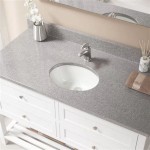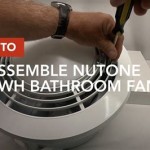Installing a Bathroom Sink Pop-Up Assembly: A Comprehensive Guide
The pop-up drain assembly is a critical component of any bathroom sink, responsible for controlling the flow of water in and out of the basin. Over time, these assemblies can corrode, leak, or simply fail, necessitating replacement. Installing a new pop-up assembly is a task that many homeowners can undertake with basic plumbing knowledge and the right tools. This article provides a detailed guide to successfully installing a bathroom sink pop-up assembly.
Before commencing any plumbing work, it's crucial to prioritize safety. Always turn off the water supply to the faucet. Typically, shut-off valves are located under the sink, one for hot water and one for cold. Turn both valves clockwise until they are fully closed. Once the water supply is shut off, open the faucet to relieve any residual pressure in the lines. In addition to water shut-off, using safety glasses is recommended to protect against potential debris while working under the sink. A work light may also be necessary to provide adequate illumination in the often-dark under-sink cabinet. Laying down a protective covering, such as a drop cloth or old towel, will protect the cabinet floor from water and stray parts.
Necessary Tools and Materials
Having the right tools and materials on hand before starting the installation process will streamline the job and minimize frustration. The following items are typically required:
- New pop-up drain assembly: Ensure the assembly is compatible with the sink's drain hole size and faucet style.
- Basin wrench: This specialized wrench is designed to reach and grip nuts in tight spaces, such as those under the sink.
- Adjustable wrench: A standard adjustable wrench is useful for tightening and loosening various nuts and fittings.
- Plumber's putty: This pliable compound creates a watertight seal between the sink and the drain flange.
- Teflon tape (plumber's tape): Used to seal threaded connections and prevent leaks.
- Channel-lock pliers: These pliers provide a strong grip for holding pipes and fittings.
- Screwdriver: A flathead or Phillips head screwdriver may be needed depending on the specific pop-up assembly.
- Clean rags or paper towels: For cleaning up spills and excess plumber's putty.
- Bucket: To catch any remaining water in the drain pipes.
- Gloves: To protect hands from dirt and grime.
With all the necessary tools and materials readily available, the installation process can proceed efficiently.
Removing the Old Pop-Up Assembly
The first step is to remove the existing pop-up drain assembly. This can often be the most challenging part of the process, especially if the assembly is old and corroded. Follow these steps carefully:
- Disconnect the Pop-Up Rod: Locate the pop-up rod, which is typically a metal rod extending from the faucet down to the drain assembly. Disconnect it from the horizontal pivot rod that connects to the pop-up stopper inside the drain. Depending on the design, this may involve loosening a screw or clip.
- Loosen the Pivot Rod Nut: Using an adjustable wrench, carefully loosen the nut that secures the horizontal pivot rod to the drain body. Once loosened, pull the pivot rod out. Be prepared for some residual water to drain out.
- Disconnect the Tailpiece: The tailpiece is the vertical pipe that connects the drain assembly to the P-trap. Use channel-lock pliers or an adjustable wrench to loosen the slip nuts that connect the tailpiece to both the drain assembly and the P-trap. Carefully remove the tailpiece.
- Loosen the Drain Nut: This is the large nut that secures the drain assembly to the sink. Using a basin wrench, grip the nut and turn it counterclockwise to loosen it. This nut can be very tight, especially if it has been in place for a long time. It may require significant force to loosen. If necessary, use penetrating oil to help loosen the nut.
- Remove the Old Drain Flange: Once the drain nut is completely loosened, you should be able to push up on the drain assembly from underneath the sink. This will separate the drain flange from the sink. If the flange is stuck, gently use a putty knife to break the seal of the old plumber's putty. Clean the sink surface thoroughly, removing all traces of old putty and debris.
After disassembling the old pop-up assembly, it is important to thoroughly clean the area around the sink drain opening to ensure a good seal with the new assembly.
Installing the New Pop-Up Assembly
With the old assembly removed and the area cleaned, the new pop-up assembly can be installed. Carefully follow these steps to ensure a proper installation:
- Apply Plumber's Putty: Roll a rope of plumber's putty and apply it to the underside of the new drain flange. Ensure the putty forms a continuous, unbroken ring around the drain opening. This will create a watertight seal between the flange and the sink.
- Insert the Drain Flange: Carefully insert the drain flange into the drain opening from above the sink. Press down firmly to seat the flange and create a good seal with the putty. Remove any excess putty that squeezes out from under the flange.
- Install the Lower Portion of the Assembly: From underneath the sink, slide the rubber or fiber washer, followed by the cardboard washer (if included), onto the threaded portion of the drain flange. Then, screw on the drain nut, tightening it by hand as much as possible.
- Tighten the Drain Nut: Use a basin wrench to further tighten the drain nut. Ensure the flange is properly aligned and centered in the sink opening. Tighten the nut gradually and evenly, checking for any leaks as you tighten. Avoid overtightening, as this can damage the sink or the drain assembly.
- Install the Pivot Rod: Insert the rubber or plastic seal into the drain body where the pivot rod will connect. Then, insert the pivot rod through the hole in the drain body and into the pop-up stopper. Secure the pivot rod with the nut, tightening it snugly but not too tightly. The pivot rod should move freely without leaking.
- Connect the Pop-Up Rod: Connect the pop-up rod from the faucet to the pivot rod. Adjust the length of the pop-up rod to achieve the desired range of motion for the stopper. Secure the connection with the screw or clip provided.
- Connect the Tailpiece: Reconnect the tailpiece to the drain assembly and the P-trap, tightening the slip nuts securely. Ensure the tailpiece is properly aligned to prevent leaks.
Ensuring each component of the pop-up assembly is correctly installed and tightened contributes to the overall performance and longevity of the plumbing system, minimizing water wastage and potential damage.
Testing for Leaks
After the pop-up assembly is installed, it is crucial to thoroughly test for leaks. This will prevent water damage and ensure the assembly is functioning correctly. Follow these steps to test for leaks:
- Turn on the Water Supply: Slowly turn on the hot and cold water supply valves under the sink. Observe the connections carefully for any signs of leaks.
- Fill the Sink: Close the pop-up stopper and fill the sink with water. Check the drain flange and the tailpiece connections for leaks. Also, check the area around the pivot rod for leaks.
- Drain the Sink: Open the pop-up stopper and allow the water to drain. Observe the drain assembly and the tailpiece connections for leaks as the water drains.
- Inspect All Connections: Carefully inspect all connections for any signs of water. If you find a leak, tighten the corresponding nut or fitting slightly. If the leak persists, disassemble the connection, inspect the sealing surfaces, and reassemble with fresh plumber's putty or Teflon tape as needed.
If any leaks are detected, identify the source and address it immediately. Common leak locations include the drain flange, tailpiece connections, and pivot rod connection. Persistent leaks may require professional plumbing assistance.
Proper installation of a bathroom sink pop-up assembly requires careful attention to detail and adherence to these steps. By following this comprehensive guide, homeowners can effectively replace their old pop-up assembly, ensuring a leak-free and functional bathroom sink.

Bathroom Sink Popup And Stopper Problems

How To Replace A Sink Stopper Quick And Simple Home Repair

How To Replace Or Maintain A Sink Pop Up Drain Assembly

How To Install A Bathroom Sink Popup Drain Stopper
How To Install Bathroom Sink Drain Queen Bee Of Honey Dos

How To Install A Metal Pop Up Sink Drain Assembly Symmons Industries

Bianchina Swapping Out A Bathroom Sink Drain And Pop Up

How To Replace Or Maintain A Sink Pop Up Drain Assembly

How To Install Bathroom Sink Drain Faucet No Leaks Under Gasket Threads Solved 2024
How To Install Bathroom Sink Drain Queen Bee Of Honey Dos







